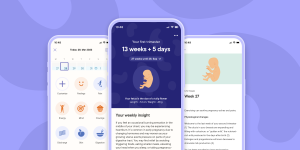Illustration by Katrin Friedmann
Vitex agnus-castus and the menstrual cycle
Most people with a cycle will experience premenstrual symptoms. These can be positive or negative, although roughly 4 in 10 people will require treatment for negative symptoms and between 3 to 8 in 100 will experience severe enough symptoms to be diagnosed with premenstrual dysphoric disorder (PMDD) (1,2).
Many people also experience cycle irregularities. Falling outside the “standard” 28-day cycle with 3–5 days of bleeding isn’t uncommon (3), but in some cases, irregularity can negatively affect a person’s health and become a cause for concern.
For premenstrual symptoms, people are sometimes prescribed combined oral contraceptives (COCs) or certain antidepressants, like selective serotonin reuptake inhibitors (SSRIs) (1). COCs are also sometimes prescribed for cycle irregularities (4) and people who experience cycle irregularities due to polycystic ovary syndrome may be prescribed drugs that stimulate ovulation (5). Although these treatments can be useful for menstrual problems, these drugs do come with negative side effects and don’t always treat all symptoms (6,7).
Outside of pharmaceutical medicines, extract from Vitex agnus-castus, also known as just agnus-castus or, in simple English, chaste tree, is a popular remedy for premenstrual symptoms and cycle irregularity in Europe and the United States (1,2,8). Drugs containing agnus-castus extract have been approved by The German Commission E (9) for the treatment of premenstrual symptoms and cycle irregularities and many forms of the extract are available for purchase in other countries.
A short history of Vitex agnus-castus
Agnus-castus is a short, berry-bearing shrub that grows naturally in Greece, Italy and parts of the Middle East. It has been used since antiquity throughout Europe, the Middle East and North Africa to treat a variety of problems, including amenorrhea (when menstruation stops) and to promote fertility (by encouraging regular ovulation). Medicine from agnus-castus is made from the berry. Modern scientists began testing its effectiveness in treating problems related to menstruation and menopause in the early 1900s, a study that continues today (8).
Association with premenstrual symptoms
Agnus-castus extract is effective at preventing many symptoms associated with premenstrual syndrome (PMS) and PMDD in comparison with a placebo and other treatments for premenstrual syndromes across different races and ethnicities (2,10–17). Agnus-castus extract may best treat breast tenderness, as this symptom improves at a lower dose compared with other PMS symptoms (15).
In studies using a placebo comparison, which means some people were given agnus-castus and others were given a fake medicine with no effect (i.e. a placebo), agnus-castus significantly reduced both the severity and presence of PMS symptoms compared with the placebo (2,12,15). This suggests that people taking agnus-castus were actually improving (and not just thinking they were, which is known as the “placebo effect”).
In two studies comparing agnus-castus extract with fluoxetine, one type of SSRI or antidepressant, agnus-castus was not as good at treating some or all symptoms (2,18,19), but it did help to improve symptoms (2,18,19).
These studies suggest that agnus-castus may not be as strong as traditional pharmaceutical treatments, but still has a beneficial effect on negative premenstrual symptoms.
Medicines containing agnus-castus extract are well-tolerated and seem to produce few side effects (2,9,13,15,18). In a large open-enrollment study without a placebo, the most common side effects were skin problems, such as itchiness and some mild gastrointestinal symptoms (13). In a review study of the side effects of agnus-castus, the authors found that some people experienced rashes, nausea or changes to their menstrual cycle (9). These side effects were generally rare and participants and healthcare professionals in most studies reported that side effects are, at worst, mild (2) and stop upon discontinuation (9).
In one study, 6 in 10 participants said they would continue using an effective dosage of the extract after 3 months (15). This suggests the benefits from the extract outweighed the negative side effects for these participants.
Association with cycle regularity
Agnus-castus may improve cycle regularity in some people. In studies comparing agnus-castus extract to a placebo, agnus-castus led to improved cycle regularity in people with irregular periods or hyperprolactinemia (5). In these subgroups, the length of the luteal phase was increased by agnus-castus (5). This is important because a shortened luteal phase is associated with decreased fertility and period irregularity via progesterone insufficiency (5,20). More and larger studies are needed to confirm these findings, but studies using animal models have found similar results (5).
Agnus-castus may also cause irregularities in people with regular cycles, though this has been rarely reported in clinical trials (9).
Biology of agnus-castus
The primary way agnus-castus affects the menstrual cycle is by stimulating dopamine receptors in the brain (2,9–11,21). Dopamine is a neurotransmitter that affects many bodily processes, including alertness (22) and hormone release (11). Agnus-castus binds to dopamine receptors in the hypothalamus and pituitary gland (1). This can lead to a decrease in the release of the hormone prolactin (9–11), among other hormones. Prolactin is the primary hormone responsible for promoting lactation, or the creation of milk in pregnant and postpartum people (11). Your body releases this hormone during the luteal phase in order to prepare your body for pregnancy if one should occur during your cycle (2).
Prolactin release is one of the reasons people may experience enlarged, swollen or tender breasts approaching menstruation (2). When prolactin levels are especially high, a person may be diagnosed with hyperprolactinaemia (5). Hyperprolactinaemia is associated with decreased progesterone, another important reproductive hormone. Some people may experience infertility due to decreased progesterone because progesterone is important for fetal development (2).
When agnus-castus stimulates dopamine receptors, this, theoretically, decreases the amount of prolactin produced, leading to a decrease in premenstrual syndromes and possible changes to progesterone levels (9–11). These changes to progesterone levels may also affect the length of the luteal phase and affect cycle irregularity (20).
If you think that you’d like to add agnus-castus to your healthcare routine, talk to your healthcare provider to make sure it’s a good fit for you. Because of this dopaminergic effect, people using dopamine antagonists, or drugs that are meant to reduce dopamine stimulation, should talk to a healthcare provider before using agnus-castus to make sure there are no interactions.
If you decide to try agnus-castus extract in some form, you can use Clue to track if and how agnus-castus affects your menstrual-cycle experience.
Download Clue to track both positive and negative changes throughout your menstrual cycle.





